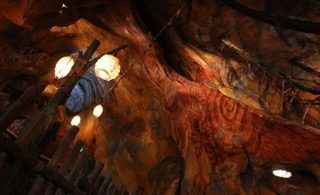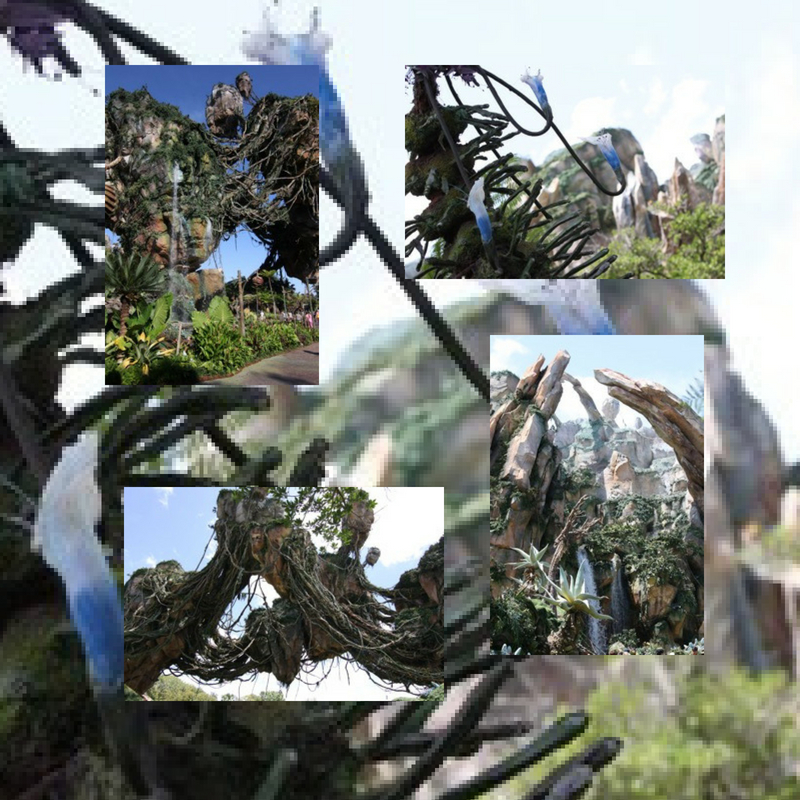 What Makes Pandora Real? An Artist’s Perspective
What Makes Pandora Real? An Artist’s Perspective
by Marisa Alvarado
Kaltxì, that’s “Hello” in Na’vi. It is so easy to pick up a bit of the native language when visiting Pandora because of how immersive of an experience it is. You might be thinking, Native language? This is an imaginary world! To that I would say, take a trip to the World of Avatar and you would think otherwise.
The genius Disney Imagineers who brought the world derived from James Cameron’s dream had to consider several questions as a creative team – What inspiration can we take from the film and integrate into our current environment/theme of Animal Kingdom Park? How can we create a world that stays true and feels incredibly real?
What makes something real? Think about it. Every experience you have had thus far is real. You can remember the warmth of the sun as its rays touched your skin, the smell of a love one’s perfume, the vibrant color of a butterfly as a fluttered past your face, the softness of a pet’s fur, the list can go on and on. Our senses guide us through every experience and leave us with a memory of a fleeting moment in our lives. The Disney Imagineers consider this with every project in which they embark. There is a vision first and then a translation into our concept of reality.
Pandora – The World of Avatar provides an invitation to your senses. Every color, form, texture, space, and detail each carry a personality. As we interact with each of these elements we are left with a feeling and a message from this unique world. As you rub the gooey, textured belly of the Flaska Reclinita, you are surprised by its reaction to such a disturbance. While walking through the land, you can see traces of broken down, rusticated metals, such as a chopper that has crashed or a stairwell whose floor has fallen through, generating a notion of an unfriendly past now overcome by nature. All the subtleties combine, telling us this world has a past, a culture, a delicate nature that must be conserved.
Check out Marisa’s full gallery of amazing Pandora – The World of Avatar photos below

The next time you visit Pandora, look closely at each species of plant. While they are vastly different, they are all connected. Likenesses can be draw to the behavior of plant-life as we know it. Flowers and fronds reaching out to the light. Roots and vines creating a supportive structure. Variety of textures native to each species’ existence. Such attention to the botanical nature of this incredible world parallels the work of some of the art masters throughout history.
![]()
Take the Romantic artists of the Hudson River School for example. Figures such as Thomas Cole, Frederic Edwin Church, and Albert Bierstadt, were inspired by European contemporaries who sought to transform the purpose and composition of artworks to something that would express aspects of the past, the inner mind, the truth and beauty of nature, in addition to the exotic and emotional contexts of their subjects. There was almost a religious connection between the vast landscapes depicted and the viewer or artist creating the work. Joe Rohde has noted in his social media posts that these artists have served as one of the many inspirations behind Pandora and it is evident in its portrayal and the story behind its mythological creation. In the film, Eywa was introduced as the deity that protects all living things. Every living, breathing being that exists in Pandora is said to be connected to her. As the sun falls in the Animal Kingdom, we are invited to see the magnificence that is the bioluminescence. The flora and fauna emit vibrant colors that dance and unite like a neural link to their deity. The Na’vi also have similar light receptors on their skin, as seen by the entrancing Shaman of Songs and the beautiful Neytiri who resides in the Windtraders Shop.
The wonder of this land does not cease with the bioluminescence but continues with the valley’s crowning glory. An incredible architectural feat in their own right, the floating mountains evoke the grandiose nature of Baroque art and architecture. During the Baroque era, artists and architects sought to explore portrayals of motion, space, light, and theatricality. Facades of buildings soared with distinct verticality that played with pockets of light and shade while artists pushed the bounds of fresco painting, dissolving ceilings with a look into the heavens. The aforementioned Baroque ideas in addition to various trompe l’oeil techniques (meaning “to fool the eye” in French) such as forced perspective and aerial perspective help bring the floating mountains to reality.

There is no place on earth that does a queue better than Disney and their finest is most definitely at Flight of Passage. As you are winding through the line, anxiously awaiting one of the most thrilling and visually stunning rides of our time, you are continuously immersed in the story of Pandora. Through the landscape you see the natural and dyed fibers spun around certain structures awakening feelings of the native culture of Papua New Guinea, to where Disney Imagineers have visited and studied on many occasions. Later, you are led into a dim, cave-like space fashioned with symbols similar to the Aboriginal people of Australia. In Aboriginal culture, every line and shape have meaning and are used to express a journey taken, regardless of the outcome. Many of the lines that adorn this part of the queue express the unity throughout all life forms, some of which are also depicted on the walls. Simplified blue Ikran fly about the walls and encounter the largest drawing, that of Toruk or “Last Shadow,” the most fearsome creature of all. These cave drawings are evocative of those charcoal and pigment illustrations during the Stone Age. Cave paintings of the Stone Age were thought to have a variety of purposes. It was not until the Mesolithic period that we saw the introduction of man and later, landscapes during the Neolithic period. The original images featured were those of animals – thought to be sacred in addition to being hunted. The images we see on the Pandoran cave may have a similar meaning to the Na’vi. Sentiments of the film cross over into this space as Neytiri instructed Jake Sully in the matter of hunting and respecting the creatures in a ceremonial sense. The Ikran and Toruk featured in the cave serve much like the instructions of the Stone Age – these are strong powerful creatures that must be revered and in some respects feared.
![]()
Passing through the orange airlock doors identical to those shown in the film and entering into the lab, the feeling changes. The sleek, mechanical, sterile, and type-faced quality of the branding throughout the queue and beyond informs the viewer of the role that man plays in the tale. Scientific instruments, texts, electronics, and notations permeate the surroundings as you see the Alpha Centauri Expedition team examining the lifeforms of Pandora, even giving life to their very own avatar. Personal items also appear amongst the scientists’ belongings – this is where the Imagineers get to play. Look closely at some of the items that appear just beyond the scientific work in progress. There are drawings, knickknacks from Team Banshee, letters, and textbooks, even one from Jane Goodall.
While the sources of inspiration may be centuries old or reside within one’s dream, every detail infused into this land allows every visitor to connect on a personal level, through the senses, acquired knowledge and emotional understanding/navigation … all of which make Pandora – The World of Avatar REAL.
Are you passionate about Disney? Do you want to be a contributing author to WDW Kingdom like Marisa? Use the contact us button on the top of this page and reach out. We look forward to hearing from you!




